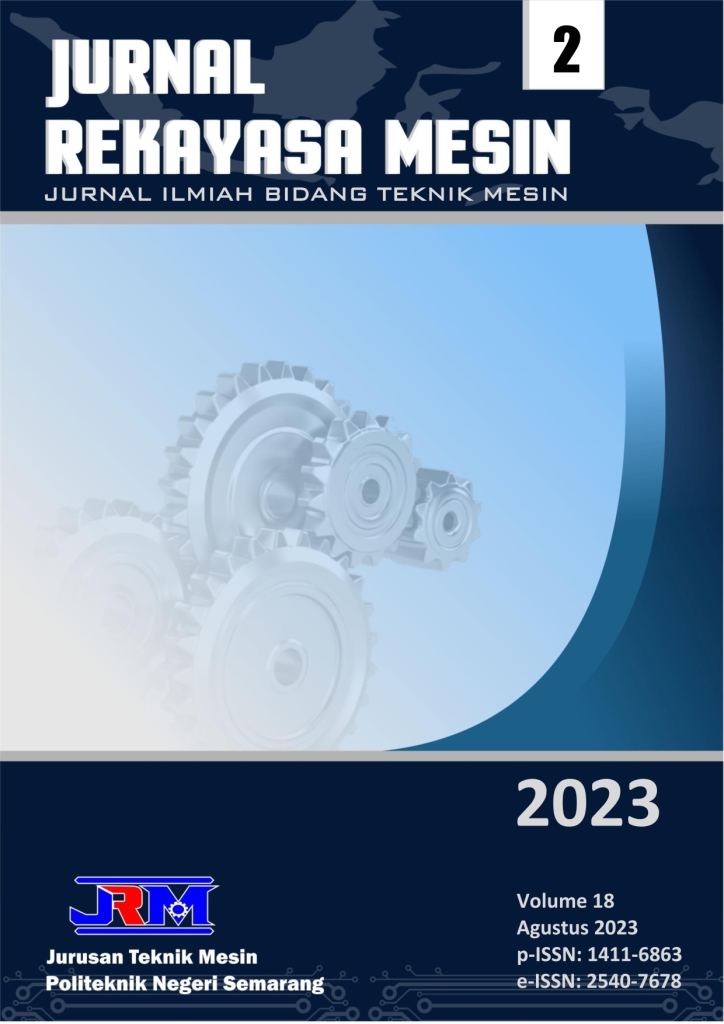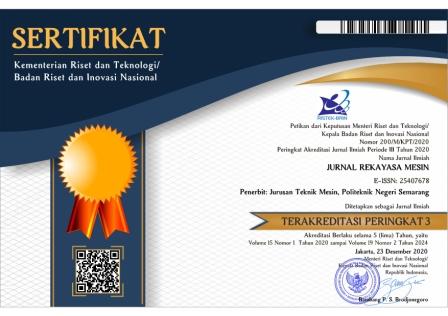Optimasi Parameter Pembuatan Sampel Kampas Rem Non-asbestos Organic (NAO) terhadap Kekerasan dan Porositas Menggunakan Metode Taguchi
DOI:
https://doi.org/10.32497/jrm.v18i2.4112Keywords:
kampas rem non-asbestos organic, metode Taguchi, kekerasan, porositas, ANOVAAbstract
Kampas rem Non-asbestos Organic (NAO) mulai dikembangkan karena lebih ramah lingkungan. Pembuatan kampas rem melibatkan banyak parameter proses sehingga membutuhkan eksperimen, waktu, dan biaya yang banyak. Penelitian ini bertujuan mendapatkan parameter yang optimal pada sampel kampas rem NAO terhadap kekerasan dan porositas dengan menggunakan Metode Taguchi. Desain parameter yang digunakan terdiri dari 3 faktor terkontrol (tekanan kompaksi, temperatur postcuring, dan waktu postcuring) masing-masing parameter terdiri dari 3 level (tekanan kompaksi : 3 Ton, 4 Ton, dan 5 Ton; temperatur postcuring: 155 °C, 160 °C, dan 165 °C; waktu postcuring: 6 jam, 8 jam, dan 10 jam). Taguchi Orthogonal Array yang dipilih adalah L9. Pengujian kekerasan sampel dilakukan dengan menggunakan Rockwell skala S dengan mengacu ASTM 785 dan pengujian porositas sampel mengacu pada JIS 4418:1996. Selanjutnya, hasil eksperimen pengujian kekerasan dan porositas dianalisa dengan menggunakan Analysis of Variance (ANOVA). Karakteristis kualitas signal-to-noise (S/N ratio) untuk respon kekerasan dipilih large is better dan respon porositas dipilih smaller is better. Hasil analisis ANOVA dan S/N ratio menunjukkan bahwa tekanan kompaksi memberikan pengaruh yang signifikan terhadap nilai kekerasan dan porositas sampel. Faktor terkontrol tekanan kompaksi 5 Ton, temperatur postcuring 165 °C, dan waktu postcuring 10 jam menunjukkan parameter yang optimal untuk menghasilkan nilai kekerasan dan porositas sampel paling baik. Nilai prediksi kekerasan dan porositas pada parameter optimal yang didesain dengan Metode Taguchi menunjukkan konsisten/sesuai dengan hasil konfirmasi eksperimen dengan 95% confidence interval (CI).
References
J. Bijwe, Composites as Friction Materials : Recent Developments in Non-Asbestos Fiber Reinforced Friction Materials-A Review.1997; 18 (3): p.1.
S. N. Nagesh, C. Siddaraju, S. V. Prakash, and M. R. Ramesh, Characterization of Brake Pads by Variation in Composition of Friction Materials. Procedia Mater. Sci. 2014; 5:295”“302.
N. S. M. EL-Tayeb and K. W. Liew, On the dry and wet sliding performance of potentially new frictional brake pad materials for automotive industry. Wear. 2009; 266 (1”“2): p. 275”“287.
Nidhi, J. Bijwe, and N. Mazumdar, Influence of amount and modification of resin on fade and recovery behavior of non-asbestos organic (NAO) friction materials. Tribol. Lett. 2006; 23 (3): p. 215”“222.
A. L. Crăciun and C. Pinca-Bretotean, Advanced materials with natural fibred reinforced aluminiu composite for automotive brake disc. Solid State Phenom. 2016; 254 (1) : p. 91”“96.
A. M. Zaharudin, R. J. Talib, M. N. Berhan, S. Budin, and M. S. Aziurah, Taguchi method for optimizing the manufacturing parameters of friction materials. Int. J. Mech. Mater. Eng. 2012; 7 (1): p. 83”“88.
M. Modi, G. Agarwal, V. Patil, U. Bhatia, and R. Pancholi, Parametric optimization in drilling of Al-SiC composite using taguchi method. Int. J. Sci. Technol. Res. 2019; 8 (9): p. 2019”“2022.
A. O. A. Ibhadode and I. M. Dagwa, Development of Asbestos-Free Friction Lining Material from Palm Kernel Shell. Journal of Brazilian Soc. Mech. Sci. Eng. 2008; 30 (2): p. 166”“173.
R. Ertan and N. Yavuz, An experimental study on the effects of manufacturing parameters on the tribological properties of brake lining materials. Wear. 2010; 268 (11”“12): p. 1524”“1532.
P. Nawangsari, Jamasri, and H. S. B. Rochardjo, Effect of Phenolic Resin on Density, Porosity, Hardness, Thermal Stability, and Friction Performance as A Binder in Non-Asbestos Organic Brake Pad. IOP Conf. Ser. Mater. Sci. Eng. 2019; 547 (1)
R. K. Roy, A Primer on the Taguchi Method. 2010.
R. B. Mathur, P. Thiyagarajan, and T. L. Dhami, Controlling the Hardness and Tribological Behaviour of Non-asbestos Brake Lining Materials for Automobiles. 2015; 3 (1): p.1
K. Dehnad, Quality Control, Robust Design, and The Taguchi Method. 1989.
G. S. Upadhyaya, Powder Metallurgy Technology. Cambridge Int. Sci. Publ. 2014; 1: p. 1”“5.
F. T. and R. Oberacker, Introduction to Powder Metallurgy. 1993.
J. M. C. Azevedo, A. C. Serrenho, and J. M. Allwood, The deformation of metal powder particles: Hardness and microstructure. Procedia Eng. 2017; 207: p. 1200”“1205.
L. R. O. H.F. Fischmeister, E.Artz, Particle deformation and sliding of spherical powders.PDF. Powder Metallurgy. 1978; 21(4): p. 179”“187.
Ö. Güney and E. Demirkesen, Influence of Curing Conditions on the Mechanical Properties of Silica-Phenolic Composites : A Comprehensive Study. 2015; 2 (11): p.1.
M. Seyednezhad, A. Rajabi, A. Muchtar, M. Rao, and P. Ooshaksaraei, Journal of Asian Ceramic Societies Effect of compaction pressure on the performance of a non-symmetrical NiO ”“ SDC / SDC composite anode fabricated by conventional furnace. Integr. Med. Res. 2017; 5 (2): p. 77”“81.
W. Wang, Effect of Powder Type and Compaction Pressure on the Density , Hardness and Oxidation Resistance of Sintered and Steam-treated Steels. 2007; 16 (2): p. 533”“538.
O. Skrinjar and P. L. Larsson, On discrete element modelling of compaction of powders with size ratio. Comput. Mater. Sci. 2004, 31 (1-2): p. 131-146.
R. German, Powder Metallurgy and Particulate Material Processing. 1992.
F. Yusubov, Optimum design of brake friction composites.Tribologi Online. 2021; 30 (2) : p. 133”“148.
A. Aruniit, J. Kers, A. Krumme, T. Poltimäe, and K. Tall, Preliminary Study of the Influence of Post Curing Parameters to the Particle Reinforced Composite ”™ s Mechanical and Physical Properties. 2012; 18 (3): p.1.
D. Pupan, C. Suvanjumrat, and W. Chookaew, Effect of Post-Curing Temperature and Mechanical Surface Treatment on Shear-Bond Strength of Asbestos-Free Brake Pad. Key Eng. Mater. 2017; 751: p. 131”“136.
Downloads
Published
How to Cite
Issue
Section
License
Copyright of articles that appear in Jurnal Rekayasa Mesin belongs exclusively to Penerbit Jurusan Teknik Mesin Politeknik Negeri Semarang. This copyright covers the rights to reproduce the article, including reprints, electronic reproductions, or any other reproductions of similar nature.







